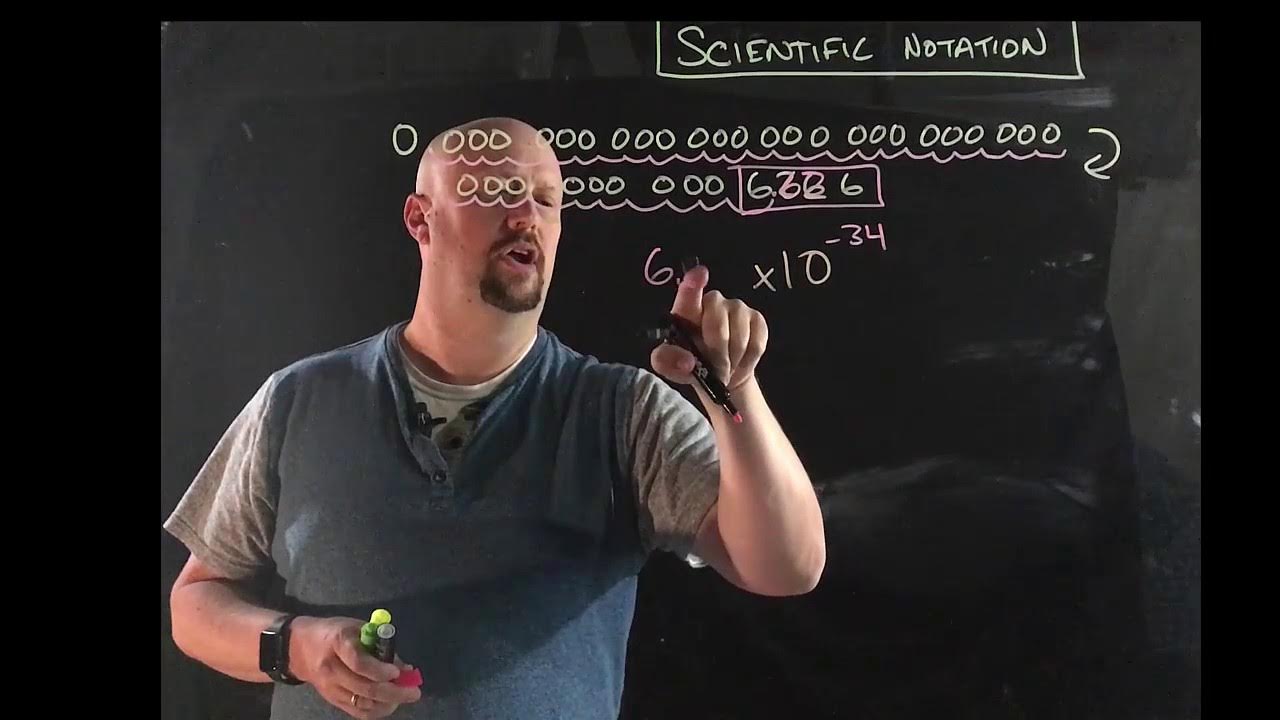SPH3U - (Video 2) Scientific Notation
Summary
TLDRThis video script explains the concept of scientific notation, particularly focusing on how physicists use it to manage extremely large or small measurements. It covers how to convert large numbers like 37 million meters into scientific notation by shifting the decimal point and using exponents. The script provides clear examples of both positive and negative exponents, demonstrating their practical application. Additionally, it tackles how to convert values like 0.00352 into proper scientific notation and discusses handling non-standard forms such as 700 nanometers, ensuring a clear understanding of the technique.
Takeaways
- 😀 Scientific notation is a useful tool for handling large and small numbers in physics, making calculations more manageable.
- 😀 To convert a large number into scientific notation, shift the decimal point left by the number of places equal to the exponent of 10.
- 😀 For small numbers, shift the decimal point to the right, resulting in a negative exponent.
- 😀 The exponent indicates how many places the decimal point has moved, with a positive exponent for large numbers and a negative exponent for small ones.
- 😀 Scientific notation is based on powers of 10, with 10 to the power of 0 equal to 1, 10 to the power of 1 equal to 10, and so on.
- 😀 Dividing numbers with the same base results in subtracting their exponents (e.g., 10^1 ÷ 10^1 = 10^0).
- 😀 Numbers less than 1, like 0.1 or 0.01, can be represented as 10 to the negative exponents (e.g., 0.1 = 10^-1).
- 😀 For numbers like 0.00352, we can convert them into scientific notation by shifting the decimal and assigning a negative exponent (e.g., 3.52 × 10^-3).
- 😀 The metric prefix 'nano' (n) represents 10^-9, so 700 nanometers equals 700 × 10^-9 meters.
- 😀 When dealing with non-standard scientific notation, the exponent should be adjusted to make the number fit the format of proper scientific notation (e.g., 700 × 10^-9 becomes 7.00 × 10^-7).
Q & A
What is scientific notation and why is it important in physics?
-Scientific notation is a way of expressing very large or very small numbers as a product of a number between 1 and 10, and a power of 10. It simplifies calculations and makes it easier to represent and manipulate extremely large or small measurements, which is common in physics.
How do you convert a large number like 37,000,000 into scientific notation?
-To convert 37,000,000 into scientific notation, shift the decimal point seven places to the left, which gives you 3.7. This makes the scientific notation: 3.7 × 10^7.
Why is the exponent positive when converting large numbers into scientific notation?
-The exponent is positive when converting large numbers because you move the decimal point to the left. A positive exponent indicates how many times you multiply by 10 to get back to the original number.
How do you convert a small number like 0.00000352 into scientific notation?
-To convert 0.00000352 into scientific notation, shift the decimal point six places to the right, resulting in 3.52. The scientific notation is then 3.52 × 10^(-6). The negative exponent reflects how many times you divide by 10 to get to the original number.
What does the negative exponent in scientific notation indicate?
-A negative exponent indicates that the number is very small and the decimal point was shifted to the right. It shows the number of times you divide by 10 to get the original value.
What happens to the exponent when converting a number like 530,000 meters into scientific notation?
-For 530,000 meters, the decimal point is shifted five places to the left, resulting in 5.3. The scientific notation is then 5.3 × 10^5, where the exponent reflects the number of places the decimal was moved.
How do you interpret scientific notation like 700 nanometers expressed as 700 × 10^(-9) meters?
-700 nanometers equals 700 × 10^(-9) meters. This is not in standard scientific notation because the number is greater than 10. To convert it, move the decimal point to get 7.00, resulting in 7.00 × 10^(-7) meters.
What is the proper scientific notation for a number like 329 × 10^7?
-To convert 329 × 10^7 into proper scientific notation, shift the decimal point so it’s between 1 and 10. This gives you 3.29, and the final scientific notation is 3.29 × 10^9.
Why is it necessary to use scientific notation in physics?
-Scientific notation is essential in physics to handle extremely large or small numbers, which occur frequently when dealing with measurements such as distances, masses, and times. It allows for easier calculations and avoids errors when working with these values.
How do you determine whether the exponent should be positive or negative when converting to scientific notation?
-If the original number is large (greater than 1), the exponent will be positive, indicating how many times you multiply by 10. If the number is small (less than 1), the exponent will be negative, indicating how many times you divide by 10.
Outlines

This section is available to paid users only. Please upgrade to access this part.
Upgrade NowMindmap

This section is available to paid users only. Please upgrade to access this part.
Upgrade NowKeywords

This section is available to paid users only. Please upgrade to access this part.
Upgrade NowHighlights

This section is available to paid users only. Please upgrade to access this part.
Upgrade NowTranscripts

This section is available to paid users only. Please upgrade to access this part.
Upgrade NowBrowse More Related Video
5.0 / 5 (0 votes)





